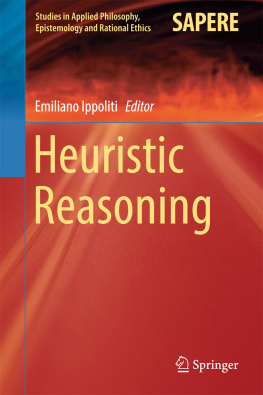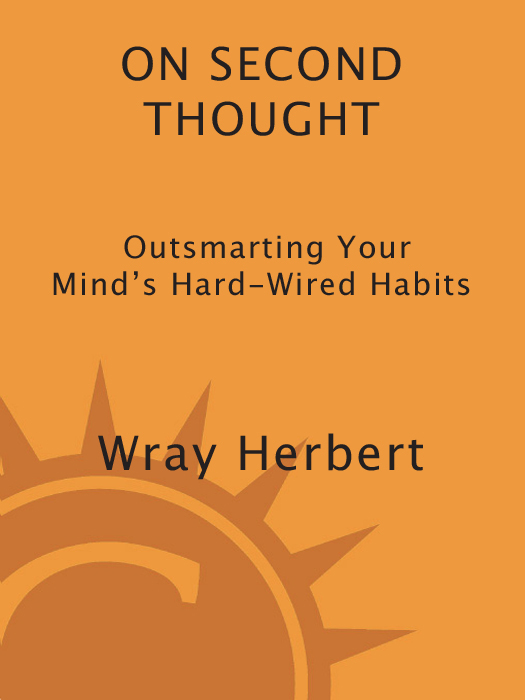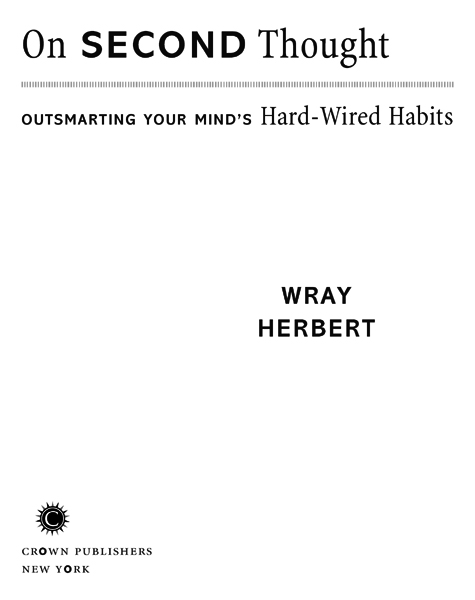Copyright 2010 by Wray Herbert
All rights reserved.
Published in the United States by Crown Publishers, an imprint of the Crown Publishing Group, a division of Random House, Inc., New York.
www.crownpublishing.com
C ROWN and the Crown colophon are registered trademarks of Random House, Inc.
Library of Congress Cataloging-in-Publication Data
Herbert, Wray.
On second thought : outsmarting your minds hard-wired habits / Wray Herbert.1st ed.
p. cm.
1. Thought and thinking. I. Title.
BF441.H46 2010
153.4dc22 2010003073
eISBN: 978-0-307-46165-0
v3.1
TO SUSIE
Introduction

O N FEBRUARY 12, 1995 , a party of three seasoned backcountry skiers set out for a day on the pristine slopes of Utahs Wasatch Mountain Range. Steve Carruthers, thirty-seven years old, was the most experienced of the group, though they were all skilled skiers and mountaineers. Carruthers had skied these hills many times and was intimately familiar with the terrain. Their plan was to trek over the divide from Big Cottonwood Canyon to Porter Fork, the next canyon to the north.
Two hours out, they met another skiing party. A storm had dropped almost two feet of new snow on the range the day before, and the two groups stood together for about five minutes, chatting about the best routes through the mountains. A couple of skiers in the other party were a bit spooked by the foggy conditions, but they all decided that they would be okay if they chose a prudent route across the lower slopes. Carruthers party broke trail through the sparse woods of Gobblers Knob.
Within the hour, Carruthers was dead. As the skiers headed across a shallow, treed expanse, they triggered an avalanche. More than a hundred metric tons of snow roared down the mountainside at fifty miles an hour, blanketing the slope and pinning Carruthers against an aspen. The other party heard the avalanche and rushed to the rescue, but by the time they dug Carruthers out, he was unconscious. He never regained awareness.
The other two skiers in Carruthers group survived, but they faced some serious criticism back home. What were they thinking? This pass was well known as avalanche terrain, and February was considered high hazard season. The chatter in the tight-knit skiing community was that Carruthers had been reckless, that despite his experience he had ignored obvious signs of danger and tempted fate.
None of this rang true to Ian McCammon. McCammon had known Carruthers for years, and the two had been climbing buddies at one time. Sure, Carruthers may have been a risk taker when he was younger, but he had matured. Just recently, while the two men were riding a local ski lift together, Carruthers had talked adoringly about his lovely wife, Nancy, and his four-year-old daughter, Lucia. His days of derring-do were over, he had told McCammon. It was time to settle down.
So what happened on that fateful afternoon? What skewed this experienced backcountry skiers judgment that he would put himself and his party in harms way? Did he perish in an avoidable accident? Saddened and perplexed by his friends death, McCammon determined to figure out what went wrong.
McCammon is an experienced backcountry skier in his own right, and a wilderness instructor, but he is also a scientist. He has a Ph.D. in mechanical engineering, and as a researcher at the University of Utah, he once worked on robotics and aerospace systems for NASA and the Defense Department. He already knew snow science pretty well, so he began reading everything he could on the science of risk and decision making. He ended up studying the details of more than seven hundred deadly avalanches that took place between 1972 and 2003, to see if he could find any commonalities that might explain his friends untimely death.
With the rigor of an engineer, he systematically categorized all the avalanches according to several factors well known to backcountry skiers as risks: recent snowfall or windstorm, terrain features like cliffs and gullies, thawing and other signs of instability, and so forth. He computed an exposure score to rate the risk that preceded every accident.
Then he gathered as much information as he could on the ill-fated skiers themselves, all 1,355 of them: the makeup and dynamics of the skiing party, the expertise of the group leader as well as the others, plus anything that was known about the hours and minutes leading up to the fatal moment. Then he crunched all the data together.
His published results were intriguing. He found many patterns in the accidents, including several poor choices that should not have been made by experienced skiers. He concluded that these foolish decisions could be explained by six common thinking lapses, and he wrote up the work in a paper titled Evidence of Heuristic Traps in Recreational Avalanche Accidents. The paper has become a staple of modern backcountry training and has no doubt saved many lives.
Heuristics are cognitive rules of thumb, hard-wired mental shortcuts that everyone uses every day in routine decision making and judgment. The study of heuristics is one of the most robust areas of scientific research today, producing hundreds of academic articles a year, yet the concept is little known outside the labs and offices of academia. This book is an attempt to remedy that.
Heuristics are normally helpfulindeed, they are crucial to getting through the myriad of decisions we face every day without overthinking every choice. But theyre imperfect and often irrational. They can be traps, as they were in the frozen mountain pass where Carruthers perished. Much has been written in the past couple of years about the wonders of the rapid, automatic human mind and gut-level decision making. And indeed the unconscious mind is a wonder. But it is also perilous. The shortcuts that allow us to navigate each day with ease are the same ones that can potentially trip us up in our ordinary judgments and choices, in everything from health to finance to romance.
Most of us are not backcountry skiers, and we will probably never face the exact choices that Carruthers and his friends faced at Gobblers Knob. But just because the traps are not life threatening does not mean they arent life changing. Here are a few of the heuristics that shaped the backcountry skiers poor choicesand may be shaping yours in ways you dont even recognize.
Consider the familiarity heuristic. This is one of the cognitive shortcuts that McCammon identified as a contributing factor in many of the avalanche incidents he studied. The familiarity heuristic is one of the most robust heuristics known, and indeed one of the original heuristics identified and studied by pioneers in cognitive science. It is a potent mental tool that we draw on every day for hundreds of decisions, and basically what it says is this: if something comes quickly to mind, trust it. It must be available in your memory for a reason, so go with it. The basic rule of thumb is that familiar equals better equals safer.




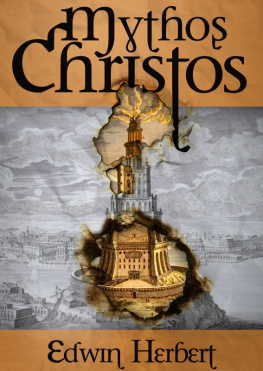
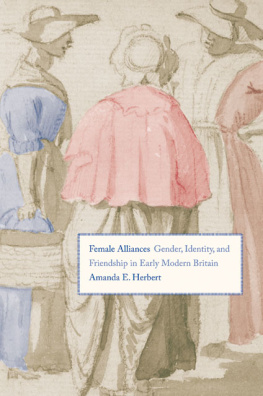


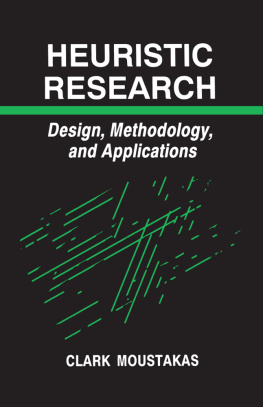
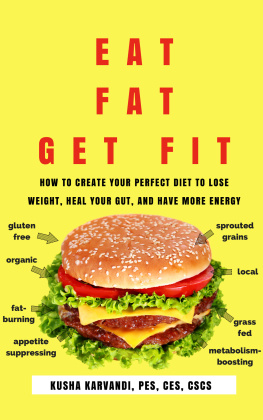



![Nisheeth Joshi [Nisheeth Joshi] - Hands-On Artificial Intelligence with Java for Beginners](/uploads/posts/book/119403/thumbs/nisheeth-joshi-nisheeth-joshi-hands-on.jpg)
